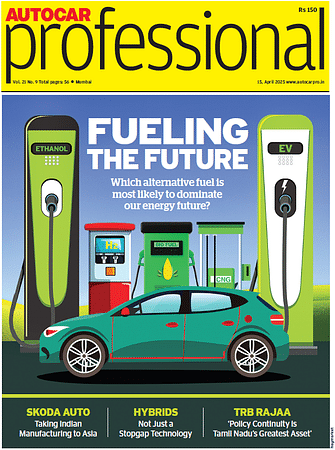India’s Auto Electrification Slows as Government Support Dries up
Surprisingly, the penetration of EVs in total sales fell to 9.9% in Mar’25 from 10.3% in Mar’24, at a time when the market has been making rosy projections for EV sales.
India’s ambitious push toward electric vehicle (EV) adoption has hit a speed bump, with the latest data from FADA Research indicating a slowdown in electrification across most vehicle categories.
The monthly figures for March 2025 (Mar’25) reveal a troubling decline in EV penetration rates compared to March 2024 (Mar’24), particularly in two-wheelers (2W) and commercial vehicles (CV).
This deceleration comes amid reduced government subsidies and incentives, notably impacting two-wheelers and passenger vehicles (PVs), especially in fleet purchases, raising questions about the sustainability of India’s EV momentum.
March Data Signals a Slowdown
The FADA Research data for March 2025 paints a striking picture of stagnating electrification efforts. The overall EV penetration rate dropped to 9.9% in Mar’25 sales, down from 10.3% in Mar’24—a year-over-year decline of 0.4 percentage points.
While this represents an improvement from 7.6% in February 2025 (Feb’25), the broader trend compared to the previous year highlights challenges in maintaining growth. It is also somewhat uncharacteristic for a market like India’s, which is just starting out on its electrification journey. The picture, however, varies according to segments:
- Two-Wheelers (2W): EV penetration in the two-wheeler segment fell to 8.6% in Mar’25, down from 9.1% in Mar’24—a decrease of 0.5 percentage points. Although this marks a recovery from 5.6% in Feb’25, the year-over-year drop signals a reversal in a segment critical to India’s mass mobility.
- Commercial Vehicles (CV): The CV category experienced a steep decline, with penetration plummeting from 2.3% in Mar’24 to just 1.0% in Mar’25—a significant drop of 1.3 percentage points. The rate remained unchanged from Feb’25, underscoring a persistent lack of progress.
- Passenger Vehicles (PV): PVs showed a slight uptick, with penetration rising to 3.5% in Mar’25 from 3.0% in Mar’24, a modest increase of 0.5 percentage points. However, this growth is overshadowed by declines elsewhere.
- Three-Wheelers (3W): Bucking the trend, three-wheelers saw penetration climb to 59.9% in Mar’25, up from 57.7% in Mar’24—a gain of 2.2 percentage points. This segment’s resilience stands in contrast to the broader market’s struggles.
Electrification has slowed in most vehicle categories, with two-wheelers and commercial vehicles showing clear declines, passenger vehicles barely advancing, and only three-wheelers maintaining meaningful growth.
Reduced Government Support Hits Key Segments
A key driver behind this slowdown is the Indian government’s decision to scale back subsidies and incentives, particularly under the Faster Adoption and Manufacturing of Electric Vehicles (FAME) II scheme. This reduction has disproportionately affected two-wheelers and passenger vehicles, segments where affordability and fleet adoption were expected to fuel growth.
- Two-Wheelers: Two-wheelers, a price-sensitive market, have been heavily reliant on subsidies to offset the higher upfront costs of EVs. With financial incentives reduced, electric two-wheelers have become less accessible to the average consumer, contributing to the 0.5% drop in penetration from Mar’24 to Mar’25. Industry observers note that this rollback has dampened enthusiasm in a segment once seen as a cornerstone of India’s EV revolution.
- Passenger Vehicles (Fleet Purchases): For PVs, the impact is most evident in fleet purchases, where the absence of subsidies has stalled electrification efforts. Fleet operators, previously incentivized to transition to electric models for cost savings over time, are now hesitant to invest without government support. This reluctance has limited PV penetration growth to a modest 0.5% increase, far below what might have been achieved with sustained incentives.
Meanwhile, the three-wheeler segment’s continued growth suggests that targeted support—possibly sustained subsidies or its entrenched role in urban transport—has insulated it from the broader policy shift. However, this exception does little to offset the declines in other categories, highlighting the uneven impact of reduced government backing.
The slowdown in March 2025 reflects deeper challenges in India’s EV ecosystem. Beyond subsidies, inadequate charging infrastructure and limited consumer awareness continue to hinder adoption, particularly in price-sensitive segments like two-wheelers and commercial vehicles. The government’s shift toward market-driven growth may be premature, as the market appears unprepared to sustain itself without policy support at this stage of penetration.
Full-Year Improvement
While the March data highlights an immediate slowdown, the full-year figures for fiscal year 2025 (FY25) provide a broader view. Overall EV penetration rose to 7.8% in FY25, up from 7.1% in FY24—a modest increase of 0.7 percentage points. Category-specific trends include:
- Two-Wheelers: 6.1% in FY25, up from 5.4% in FY24 (+0.7 points).
- Three-Wheelers: 57.3% in FY25, up from 54.2% in FY24 (+3.1 points).
- Commercial Vehicles: 0.9% in FY25, up from 0.8% in FY24 (+0.1 points).
- Passenger Vehicles: 2.6% in FY25, up from 2.3% in FY24 (+0.3 points).
This full-year growth offers a counterpoint to the March decline, suggesting some resilience in the market.
However, the 0.7% increase in total penetration is well below the expansion required for a market like India’s, where penetration remains below 10% overall. A more robust growth rate is essential to build momentum and meet climate goals, such as net-zero emissions by 2070. The current pace, particularly in light of the March slowdown, falls short of these expectations.
The March 2025 data underscores a troubling deceleration, driven by reduced government support and compounded by structural challenges. While three-wheelers offer a bright spot, the declines in two-wheelers and commercial vehicles—coupled with sluggish growth in passenger vehicles—signal a need for renewed policy focus.
Balancing market-driven growth with targeted incentives and infrastructure investment will be critical to reversing this trend and ensuring India’s electrification journey stays on track.
RELATED ARTICLES
Anchor Investment Underlines Ather Energy's Valuation Premium Over Ola Electric
Despite selling only one third the number of e-scooters as Ola Electric, Ather Energy has a valuation that is 55% that o...
No.4 Twice in a Row: What's Behind Hyundai Motor India's Underperformance
What are the factors that has led the Korean car brand, which has had a steady grip over the No.2 slot in India's car ma...
An Investors' Guide to the Indian Car Market
Nothing is permanent and we have seen the heyday of the hatchbacks and the sedans. But a close look at the momentum of g...






 By Shruti Shiraguppi & Angitha Suresh
By Shruti Shiraguppi & Angitha Suresh
 07 Apr 2025
07 Apr 2025
 3320 Views
3320 Views








 Sarthak Mahajan
Sarthak Mahajan

